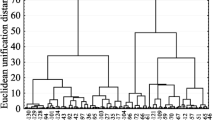Abstract
A computational neural network method was used for the prediction of stability constants of simple crown ether complexes. The essence of the method lies in the ability of a computer neural network to recognize the structure-property relationships in these host-guest systems. Testing of the computational method has demonstrated that stability constants of alkali metal cation (Na+, K+, Cs+)-crown ether complexes in methanol at 25 °C can be predicted with an average error of ±0.3 log K units based on the chemical structure of the crown ethers alone. The computer model was then used for the preliminary analysis of trends in the stabilities of the above complexes.
Similar content being viewed by others
References
J. Zupan and J. Gasteiger: Anal. Chim. Acta 248, 1 (1991).
G. M. Maggiora, D. W. Elrod, and R. G. Trenary: J. Chem. Inf. Comput. Sci. 32, 732 (1992).
J. Gasteiger and J. Zupan: Angew. Chem. Int. Ed. Engl. 32, 503 (1993).
B. G. Sumpter, C. Getino, and D. W. Noid: Annu. Rev. Phys. Chem. 45, 439 (1994).
N. Bodor, A. Harget, and M-J. Huang: J. Am. Chem. Soc. 113, 9480 (1991).
L. M. Egolf and P. C. Jurs: J. Chem. Inf. Comput. Sci.33 616 (1993), and references therein.
A. A. Gakh, E. G. Gakh, B. G. Sumpter, and D. W. Noid: J. Chem. Inf. Comput. Sci. 34, 832 (1994).
A. A. Gakh, E. G. Gakh, B. G. Sumpter, D. W. Noid, L. D. Trowbridge, and D. A. Harkins: J. Fluorine Chem. 73, 107 (1995).
B. G. Sumpter and D. W. Noid: Macromol. Theory Simul. 3, 363, (1994).
J.-M. Lehn: Angew. Chem. Int. Ed. Engl. 27, 89 (1988).
M. H. Mazor, J. A. McCammon, and T. P. Lybrand: J. Am. Chem. Soc. 111, 55 (1989).
P. D. J. Grootenhius and P. A. Kollman: J. Am. Chem. Soc. 111, 4046 (1989).
P. D. J. Grootenhius, J. van Eerden, E. J. R. Sudholter, D. N. Reinhoudt, A. Roos, S. Harkema, and D. Feil: J. Am. Chem. Soc. 109, 4792 (1987).
M. A. Thompson, E. D. Glendening, and D. Feller: J. Phys. Chem. 98, 10465 (1994).
B. P. Hay, J. R. Rustad, and C. J. Hostetler: J. Am. Chem. Soc. 115, 11158 (1993).
M. J. Kamlet, R. M. Doherty, M. H. Abraham, Y. Marcus, and R. W. Taft: J. Phys. Chem. 92, 5244 (1988).
Z.-G. Shi and E. A. McCullough, Jr.: J. Incl. Phenom. 18, 9 (1994).
R. M. Izatt, J. S. Bradshaw, S. A. Nielsen, J. D. Lamb, and J. J. Christensen: Chem. Rev. 85, 271 (1985).
R. M. Izatt, K. Pawlak, J. S. Bradshaw, and R. L. Bruening: Chem. Rev. 91, 1721 (1991).
Our preliminary computations indicate that the influence of temperature and solvent can be incorporated in neural network computing by adding two additional inputs (temperature and solvent) in the neural network architecture. For a limited set of solvents (for example, methanol, acetonitrile, water) they can be coded sequentially, 1, 2, and 3. However, for a large set of solvents a more sophisticated coding algorithm is required. These computations lie beyond the scope of the current work.
Neural network computational packages (NeuralWorks Professional II/PLUS and NeuralWorks Explorer) are commercially available from NeuralWare, Inc. (Penn Center West, Building IV Pittsburgh, PA 15276–9910) both for PC and mainframe computers. In this study we have used backpropagation-type neural networks included in this program package. For more details of neural network computing see, for example [1–4, 7], and references therein.
R. L. Bruening, R. M. Izatt, and J. S. Bradshaw: Understanding Cation-Macrocycle Binding Selectivity in Single-Solvent, Extraction and Liquid Membrane Systems by Quantifying Thermodynamic Interactions(Cation Binding by Macrocycles: Complexation of Cationic Species by Crown Ethers, Eds. Y. Inoue and G. W. Gokel), pp 111–132. Marcel Dekker, New York, NY (1990).
B. P. Hay and J. R. Rustad: J. Am. Chem. Soc. 116, 6316 (1994).
R. D. Hancock: Pure Appl. Chem. 58, 1445 (1986).
Author information
Authors and Affiliations
Rights and permissions
About this article
Cite this article
Gakh, A.A., Sumpter, B.G., Noid, D.W. et al. Prediction of Complexation Properties of Crown Ethers Using Computational Neural Networks. Journal of Inclusion Phenomena 27, 201–213 (1997). https://doi.org/10.1023/A:1007928814162
Issue Date:
DOI: https://doi.org/10.1023/A:1007928814162




